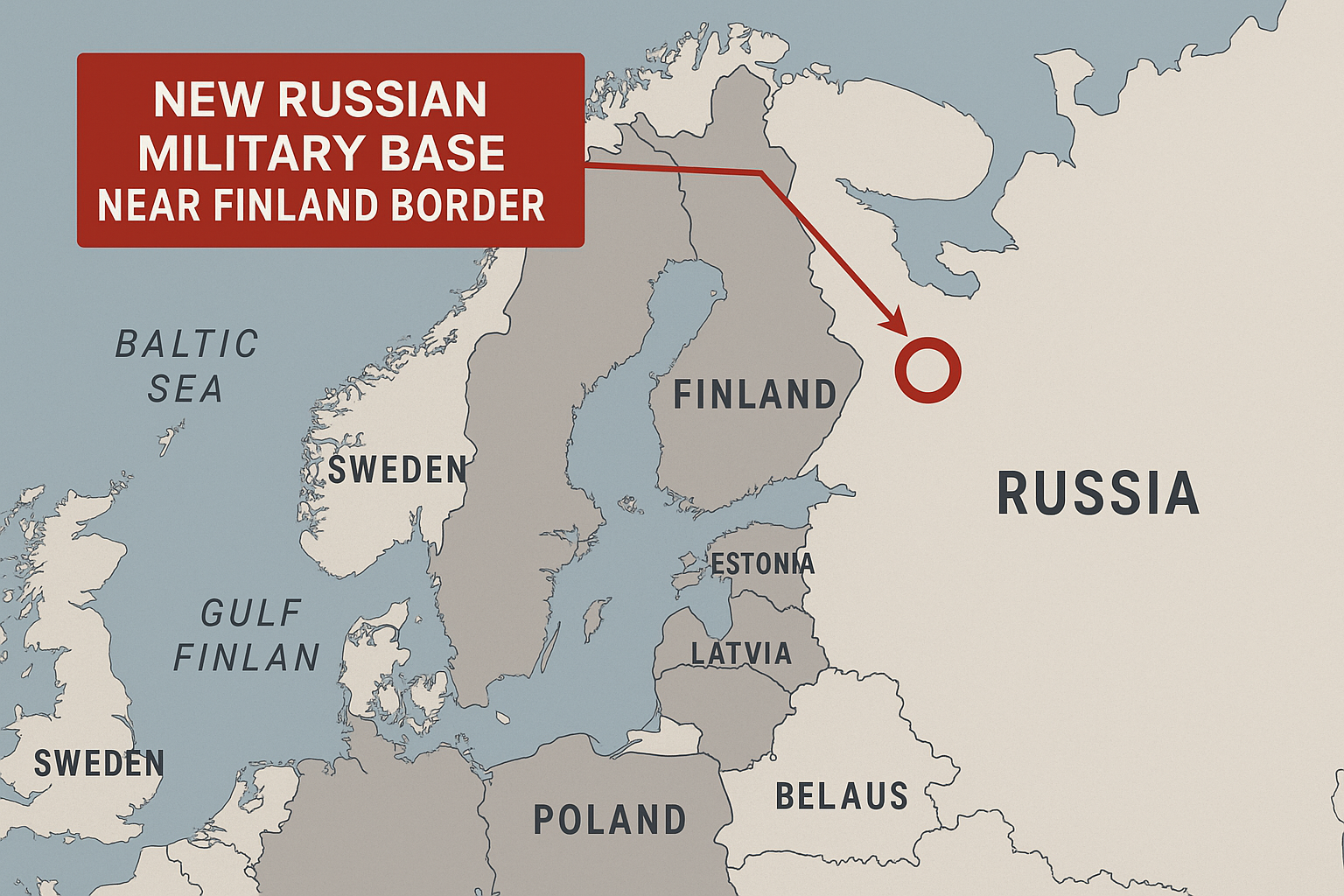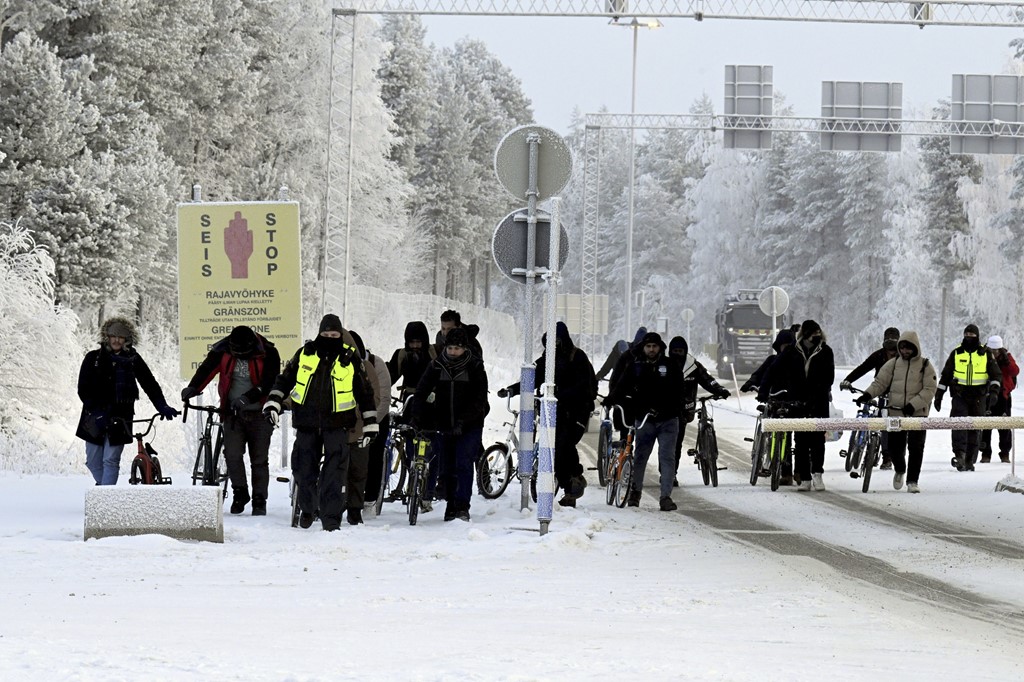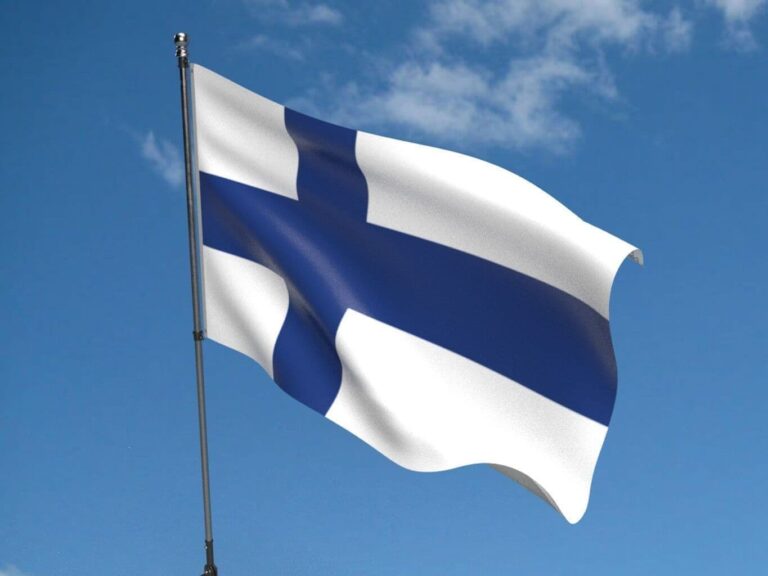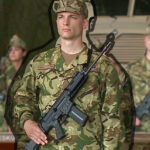Russia’s recent decision to build a new military base close to the Finnish border marks a deliberate escalation in its confrontation with NATO. This move—timed just after Finland joined NATO—signals a hardening of Moscow’s posture in the European north. The base serves as both a strategic warning and an operational platform in the Arctic-Baltic theater. This paper analyzes the timing, location, intent, capabilities, and potential scenarios of use, with attention to the broader regional and global security implications.


I. Why Now? The Timing Behind the Move
- Response to Finland Joining NATO (April 2023)
- Finland’s accession to NATO added 1,340 km of direct NATO-Russia border, a strategic shock for Moscow.
- Russia warned of “countermeasures,” and this base is Putin’s materialization of that threat.
- Escalating NATO-Russia Military Proximity
- With NATO troops rotating through Finland and Sweden, Russia sees an “encirclement pattern.”
- The base acts as a counter-pressure point.
- 2025 Political Messaging
- Coming amidst U.S. political uncertainty and NATO’s overstretched commitments, the base serves as a signal of Russian endurance and resolve.
- Internally, it feeds nationalist propaganda during wartime economic pressure.
II. Why There? Geographic and Strategic Logic
- Likely Locations: Karelia or Murmansk Region
- Karelia: Provides quick access to Finnish cities (e.g., Helsinki, Kuopio).
- Murmansk: Offers reinforcement to Russia’s Northern Fleet and Arctic command structure.
- Access to the Baltic–Barents–Arctic Triangle
- The base links Kaliningrad–Kola–Arctic military arc.
- Enhances Russia’s capacity to pressure the Baltic Sea and Arctic trade routes.
- Terrain & Infrastructure
- Proximity to the Murmansk–St. Petersburg rail and arctic supply lines.
- Remote location provides plausible deniability, covert deployment, and strategic depth.
III. What Purpose? The Mission Behind the Base
- Multi-Domain Military Platform
- Likely to include radar systems, missile batteries (Iskander/Kalibr), air-defense (S-400/500), and potentially nuclear storage.
-
- May serve as a logistics and mobilization hub for Arctic or Baltic operations.
- Symbolic and Strategic Deterrent
- Designed to intimidate Finland and NATO while giving Russia first-strike or rapid-response capacity.
- Could serve as early warning or denial-of-access outpost in case of Western troop movement.
- Information Warfare Platform
- Base may support electronic warfare, cyber ops, and psychological operations targeting Nordic countries.

IV. Impact Assessment: Regional and Global
A. For Finland
- Heightened alertness of Finnish defense forces; increased NATO integration.
- May spur further militarization of Finnish Lapland and northern borders.
B. For NATO
- Triggers need for forward deployments, especially U.S. and UK Arctic brigades.
- Diverts attention from southern flank (e.g., Black Sea, Balkans).
C. For Sweden & Norway
- Adds pressure on Sweden (just joined NATO) to build up Norrland defenses.
- Threatens Norwegian Arctic energy infrastructure and NATO radar coverage.
D. For Russia
- Strengthens military control of the High North.
- Could overstretch logistics, especially with ongoing Ukraine war and sanctions.
V. Base Capacity & Potential Use Scenarios
A. Known or Expected Capabilities:
- 5,000–8,000 troops, dual-use with Spetsnaz or VDV elements.
- S-400 or S-500 SAM batteries, short- to medium-range missile systems.
- Electronic warfare systems, Arctic-optimized radars.
- Forward helicopter and drone pad (UAVs for surveillance).
B. Scenarios of Use:
| Scenario | Description | Consequences |
| 1. Cold Posturing | Base remains symbolic, used for surveillance & readiness | Ongoing NATO-Russia tension, arms race in the North |
| 2. Crisis Escalation | Russia launches limited attack on Finnish/NATO radar or cyber infra | Direct NATO-Russia confrontation, Article 5 tension |
| 3. Baltic-Arctic Strike Node | Coordinated action from Kaliningrad, Murmansk, and new base | Major northern theater opens in wider conflict |
| 4. Nuclear Deterrent Posture | Base hosts tactical nukes as strategic message | NATO increases forward nuclear presence (e.g., Poland) |
VI. A Base That Speaks Volumes
This base isn’t just a military installation—it’s a message to NATO, a symbol of Russia’s Arctic ambitions, and a testing ground for new multi-domain warfare strategies. It gives Moscow a forward bastion to influence Nordic politics, sea lanes, and alliance cohesion.
The West must consider:
- Preemptive military planning and Arctic coordination
- Satellite monitoring of the base’s development
- Cyber and EW defense integration across Nordic NATO states
🔍 Recommended Additions
- Satellite imagery analysis (if available)
- Reactions from Finnish or Swedish defense ministries
- NATO Arctic command updates
Great follow-up. The new Russian military base near Finland would significantly expand Russia’s military capacityin the Nordic-Arctic-Baltic region in the following key ways:
🔧 How It Will Change Russian Capacity in the Region
I. From Border Gap to Forward Operating Edge
- Before Finland joined NATO, the northwest border was lightly defended due to mutual neutrality.
- This base turns that quiet border into a strategic launch pad, giving Russia:
- Surveillance reach into southern Finland and NATO infrastructure
- Strike range over Finnish airfields, radars, and Baltic Sea corridors
- Faster troop deployments via rail/road links from Murmansk and Arkhangelsk
II. Tripwire and Denial Capabilities
- Likely includes air-defense systems (S-400/500) and electronic warfare (EW) assets
- Transforms the area into an A2/AD zone (Anti-Access/Area Denial) that:
- Disrupts NATO air/naval movement in the Baltic and Arctic
- Shields Russia’s Northern Fleet and nuclear assets in Murmansk
- Blocks Finnish/Swedish military coordination with U.S./NATO
III. Increased Readiness and Rapid Response
- Hosting mobile units (Spetsnaz, Arctic brigades, VDV) would:
- Enable fast incursions or sabotage ops in northern Finland/Sweden
- Offer rear-area disruption in case of NATO Baltic deployment
- Support covert “gray zone” tactics like border provocations or cyber-attacks
IV. Expanded Strategic Depth in the Arctic
- This base would connect Kaliningrad to the Arctic, forming a military corridor:
- Enhances logistics, communications, and command resilience
- Prepares Russia for Arctic confrontation over shipping lanes and resources
- Strengthens ability to contest Norway’s Svalbard area or Nordic airspace
V. Psychological and Political Pressure
- Even without war, the base gives Moscow a constant leverage tool:
- Destabilizes Finnish/Nordic public confidence
- Forces NATO to reallocate forces northward, weakening focus elsewhere
- Test NATO’s cohesion if border tensions rise
🧠 Bottom Line
The base doesn’t just add firepower—it reshapes the entire security architecture of Northern Europe. It:
- Turns Russia’s northwest border from a defensive line into an offensive pressure zone
- Adds layered threat vectors (EW, missiles, special forces)
- Forces NATO and Finland to treat the Arctic-Baltic theater as a live front
The new Russian military base near the Finnish border could significantly enhance Russia’s capacity to threaten or attack the Baltic states (Estonia, Latvia, Lithuania) — not directly from Finland, but as part of a broader northern pincer movement. Here’s how:
🔥 How the Base Could Affect Russia’s Ability to Attack the Baltic States
I. Strategic Envelopment from the North
- Flanking Maneuver via Finland’s Airspace
- With a northern base near Finland, Russia could launch support operations or electronic warfare into Baltic airspace from a non-Kaliningrad direction.
- Even if Finland blocks direct overflights, proximity allows:
- Standoff missile strikes
- Drone operations
- Radar jamming or air denial zones around Estonia/Latvia
- Multi-front Pressure on NATO
- Russia could force NATO to defend both the Baltic front and Nordic flank, diluting NATO’s response strength in the Baltics.
- Creates a pincer threat: Kaliningrad in the west, Pskov region in the east, and now the Arctic-north flank.
II. Troop Reinforcement and Logistics Depth
- The base near Finland shortens Russia’s reinforcement lines to the Baltics via:
- Murmansk–Petrozavodsk–Pskov corridor
- Potential rail and airlift capacity from Russia’s Northern Fleet region
- Enables rapid deployment of Arctic-adapted troops or long-range artillery
- Could act as a rear echelon HQ for a larger northern campaign
III. Diversion and Deception
- The base allows distraction operations — feigned attacks or live drills near Finland to:
- Pull NATO forces north and thin out Baltic defenses
- Confuse intelligence estimates about the actual axis of invasion
- Russia has used this “maskirovka” (deception) strategy repeatedly (e.g., Crimea, Donbas)
IV. Electromagnetic and Cyber Warfare Staging
- With EW systems near Finland, Russia could:
- Disrupt NATO communications over the Baltics
- Blind Baltic radar and air-defense systems
- Launch cyber attacks on Baltic governments or infrastructure from more secure, less monitored areas
V. Operational Scenarios Enhanced by the Base
| Scenario | Base’s Role | Impact on Baltics |
| Rapid Decapitation Strike | Provides flank suppression, disrupts NATO air cover | Easier to hit Baltic command centers |
| Hybrid Warfare | Supports covert Spetsnaz infiltration via north | Expands unconventional warfront |
| A2/AD Shielding | Expands SAM coverage zone around Kaliningrad and Baltics | Limits NATO air reaction |
| Regional Escalation | Launchpad for standoff weapons into NATO logistics routes | Targets Polish–Baltic corridor (Suwalki Gap) |
VI. Limits and Risks for Russia
- Attacking from the Finnish base directly into the Baltics would mean engaging Finland and NATO full force.
- But even without direct attack, it stretches NATO’s defense bandwidth, raises Baltic insecurity, and increases Moscow’s coercive leverage.
🧠 Conclusion: A Baltic Threat Multiplier
The new base doesn’t need to fire a shot at Estonia or Latvia to matter—it:
- Adds strategic depth, confusion, and distraction
- Enables faster force rotation and threat saturation
- Creates a northern spearhead supporting Kaliningrad and Western Military District operations
The Baltic States must now consider the Arctic-north front as part of their defensive calculus, not just Belarus or Kaliningrad.
the construction of a new Russian military base near the Finnish border very much fits and revives key elements of Soviet military doctrine in the region. It aligns with Soviet-era concepts of layered defense, forward deterrence, and Arctic strategic depth, adapted to 21st-century hybrid and missile warfare.
Here’s how:
🧭 How the New Base Reflects Soviet Military Deployment Concepts
I. Strategic Buffer Zone Philosophy
- Soviet Principle: Maintain depth and buffers between NATO and key military-industrial zones (e.g., Leningrad region, Murmansk).
- Today: Russia views Finland’s NATO membership as the loss of a buffer. The new base is an attempt to recreate strategic depth and reestablish a forward shield — even on home territory.
✅ Echoes Soviet thinking: If you lose the buffer politically (e.g., Finland joining NATO), reassert it militarily.
II. Northern Theater of Operations Doctrine
- The USSR had a dedicated Northern Theater Command, integrating forces across Kola Peninsula, Karelia, and the Barents to:
- Protect the Northern Fleet (Murmansk)
- Project power across the Nordic Arctic
- Threaten NATO’s northern flank (Norway, Iceland, Greenland)
- The new base plugs into this exact same Arctic-Nordic arc, reinforcing:
- Air defense umbrella
- Submarine bastions
- Airborne and rapid-reaction staging
✅ This mirrors Cold War-era planning like the Barents–Baltic convergence axis and “Ice Curtain” operations.
III. Combined Arms Fronts & Strategic Envelopment
- Soviet doctrine emphasized multi-front coordination to:
- Envelop enemies from multiple directions
- Combine conventional, airborne, naval, and nuclear elements
- A base near Finland adds a northern axis for:
- Support to Baltic offensives
- Pressure on Sweden/Norway from the northeast
- Enabling Arctic–Baltic envelopment — a key Soviet wartime plan
✅ Fits Soviet patterns seen in:
- Baltic Military District
- Leningrad Military District
- Northern Fleet–Murmansk High Command
IV. Pre-positioning and Mobilization Infrastructure
- The Soviets built mobilization nodes across Karelia and the High North, often disguised as logistics hubs.
- Russia today uses similar strategies:
- Rail-linked depots
- Airfields with dual-use capability
- Underground fuel/ammo reserves
- The new base may serve a mobilization and dispersal function, just like its Soviet predecessors.
✅ Especially important given sanctions and war pressure — Russia may need pre-positioned forces closer to potential flashpoints.
V. Strategic Signaling to NATO
- The USSR often used bases not only to prepare for war, but to signal resolve, create negotiation leverage, or test cohesion among adversaries.
- This base sends a Soviet-style signal:
“We can escalate in a new theater you weren’t prepared for.”
✅ Classic Cold War-style coercive diplomacy by presence.
🧠 Conclusion: The Arctic Front Reborn
The new base is not an innovation—it’s a return.
Russia is resurrecting Soviet Arctic-Nordic doctrine to adapt to:
- NATO’s northward expansion
- Emerging Arctic competition
- The need for new military leverage without risking direct war
It reflects a Soviet military tradition of strategic depth, layered defense, and flanking threats, upgraded with today’s tools: EW, missiles, drones, and cyber.


More on this story: NATO is challenged: Russia starts hybrid operations on the Finnish border




